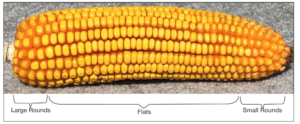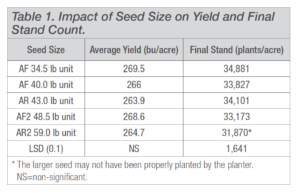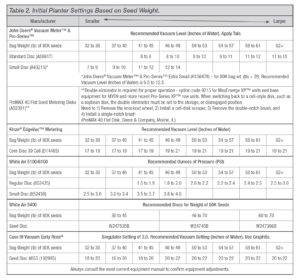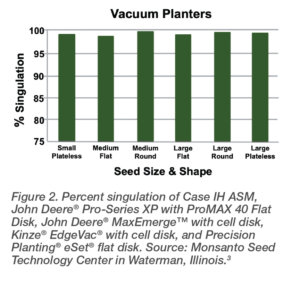There are many adjustments that can be made to a corn planter to accurately place the seed in the seed slice, to maximize the yield potential of the seed product.
- Adjustments to planter equipment can help achieve desired plant stands by minimizing doubles or skips.
- Corn seed performance can be optimized by selecting a plant population that maximizes genetic yield potential, correct corn product positioning, and adjusting planter settings to help deliver optimum seed population more accurately.
- Genetic yield potential is not affected by corn seed size or shape.
Seed Size and Yield Potential
Varying environmental conditions may result in a variety of seed sizes and shapes from the same corn product. Seed size is also affected by corn product genetics and growing conditions, especially during the pollination and grain fill period. Typically, large rounds come from the base of the ear, flats from the center, and small flats and small rounds from the tip (Figure 1). Plateless seed usually comes from the base or the ear or the tip. Regardless of size or shape, all seeds from the same ear and from the same plant have the same genetic material, and thus the same genetic yield potential.
Though genetic yield potential is not affected by seed size, there can be differences in germination related to seed size under adverse planting conditions. Large seed can have slightly decreased emergence rates in dry soil conditions because large seed requires more moisture to germinate, compared to small seed. Small seed can have slightly decreased emergence in cool or crusted soils because the energy needed for emergence in these environments may be greater than the amount stored in the endosperm. The differences noted in early growth related to seed size are usually not apparent after tasseling. Similar silking dates and grain yield are expected when emerged plant populations are the same regardless of seed size and shape.

Figure 1. Seed size and shape on a corn ear varies from large rounds (left, ear base), flats (middle of ear), to small rounds (ear tip).
Seed Weight
It is becoming more common for seed companies to sell seed based on seed count along with seed size and shape. Historically, farmers often purchase specific seed weights or seed sizes based on how their planter was configured. Today producers more often prefer to purchase seed that is consistent in bag weight to reduce the number of adjustments needed when changing from seed lot to seed lot or when changing corn products during the planting season. This information is located on the seed tag or the seed bag and will help a producer adjust the planter for optimum performance.
The seed size rating scale that Bayer uses to help producers understand the different size and shape that is given to each corn product during the screening and bagging process includes:
- AF – Medium Flat corn seed
- AR – Medium Round corn seed
- AF2 – Large Flat corn seed
- AR2 – Large Round corn seed
- P22 – Small Plateless
Different seed sizes are described along with the seed treatment, seeds per pound and the corn seed bag weight for 80,000 kernels. A study done at the Bayer Water Utilization Learning Center, Gothenburg, NE in 2017 that measures the yield potential for five different seed sizes of the same corn product and yield differenced were determined to be not significant (Table 1).

As noted above, the size and weight of the seed did not affect yield potential. Yield potential is determined by genetics, product positioning, proper seed placement in the soil and other management practices. When purchasing corn seed, it is important to review the seed bag labels and your planter manufacturer’s recommendations. Also talk with your seed brand agronomist or representative for information on dealing with different sizes and weights of seed, planter specifications, adjustments, and proper field placement. When properly managed and properly positioned, corn seed of any size and weight can produce a successful crop.
Adjusting Planters for Seed Size and Shape
Planter settings should be adjusted for accurate seed positioning, placement, and seeding rate. When adjusted for seed size, a planter can more accurately singulate (the measurement of dropping one seed at a time) and deliver seed. Planters can deliver excessive numbers of doubles (when two seeds are attached to a cell as it rotates during planting) or skips (when there is no seed attached to the cell as it is rotating) when improperly adjusted for seed size (Table 2). Consequently, grain yield potential can be reduced by 3 to 10 bushels per acre when a mis-adjusted planter does not accurately meter the seed.1

Vacuum Planters
Adjustments can be made to vacuum planters by several different methods depending on the singulation problem. Adjustment that can be made to vacuum pressure, changing disk and/or cell size, and seed singulation devices can affect plantability and singulation. Most often it is the vacuum setting adjustment that is used to make fine adjustments after the discs are selected. Depending on the disc used, planters equipped with cell or flat disks have different requirements for adjustment. Another component to examine, regardless of disk type, is the way the disk is adjusted relative to the meter housing. Having the disk rub the housing with correct light contact can help improve singulation, reduce seed damage, and help load the planter drives, improving consistency. Using talc, most often used for vacuum planters, or a blend of talc and graphite, can help improve seed flow and drop, especially when high rates of seed treatments are used and/or when planting conditions are humid. Higher amounts of talc may be necessary, for the increased surface area, when small seed is planted. Talc should be mixed well throughout the hopper or tank to provide adequate coverage.
Vacuum Planters with Cell Disks
Planter vacuum is used to partially hold the seed in place by the cell, which is matched to the seed size and shape. Plantability is aided by matching different cell sizes to fit a given seed size and shape. Disks with cells that are on the larger end of the acceptable range for a given seed size could lead to doubles, even if the vacuum pressure is adjusted to the lower end of the acceptable range. Low vacuum pressures can increase the chance of seed being shaken off of the disk when planting over rough ground or at higher planting speeds, resulting in increased skips. To help reduce doubles and skips, disks with cells on the smaller end of the acceptable range can be used while running vacuum pressures on the higher end of the acceptable range.
Vacuum Planters with Flat Disks.
Flat disks are less sensitive to different seed sizes and shapes and can provide more consistent plantability while reducing the need to adjust vacuum pressure. Examples are the Precision Planting® eSet® and vSet® systems and the John Deere® ProMAX® 40 Flat Disk. The use of flat disks usually requires an additional component or two for singulation. The eSet® and vSet® systems utilize a floating singulator that requires no adjustments for ease of use while the ProMAX® 40 Flat Disk uses a double eliminator and a knock-out wheel. Flat seed disks may require a slightly higher vacuum level, than is used on a cell disc, because there is no cell to hold the seed on the disk. Users may benefit by visiting their equipment dealer for inspection and testing of their seed meters. Always make sure to set your vacuum planter monitor to the correct number of cells for each disk used as they can change depending on the style of disk used.
High speed planting technology for vacuum planters
With the development of planter equipment that now allows the producer to plant at increased planting speed, there are few adjustments that are needed that are different than when planting with the planters without these new developments. John Deere’s ExactEmerge® and Precision Ag SpeedTube®, among other high-speed planting systems, have been developed to now allow planters to run at up to ten miles per hour. The biggest difference between these new high-speed planters and the older planter versions is a seed tube delivery system that has been developed to use a belt system to take the seed from the meter and deliver it to the seed slice. There are also several high-speed planters that use air pressure to deliver the seed to the seed slice. Non high-speed planters commonly use gravity in a seed tube to deliver the seed to the seed slice. Since most of the other planter functions are the same the only additional planter adjustments that may be recommended would be to run increased row unit downforce and increased closing wheel force. Often a hydraulic downforce system is preferred over the air downforce system due the decreased response time with a hydraulic system. The exact settings for each system will be dependent on your field conditions and spring tillage practices. In general, expect 20-40 pounds of increased downforce and one additional notch in the closing wheel pressure when planting at speeds over 8 mph.2
When possible, it is a good idea to run all planter units, each year, on a test stand to document the meter system’s performance and to check for any mis-adjustment or excessive meter wear that can negatively effects performance.
Plantability Tests
Plantability tests have been conducted to provide planter setting recommendations for seed lots. Results are represented in terms of percent singulation (the percentage of single seeds released by the seed meter at the proper time). If the seed sensor detects two seeds where only one should be, then it is called a multiple. If the seed sensor detects nothing where a seed should be, then it is considered a skip. Therefore, percent singulation is determined by taking 100% properly timed single seed drops and subtracting the percentage of multiples and skips. Figure 2 depicts singulation data for vacuum planters with various seed sizes and shapes. Simulated planter speed was 5.5 miles per hour. Data was collected using seed harvested in 2004 through 2010 for planting seasons in 2005 through 2011, respectively.

